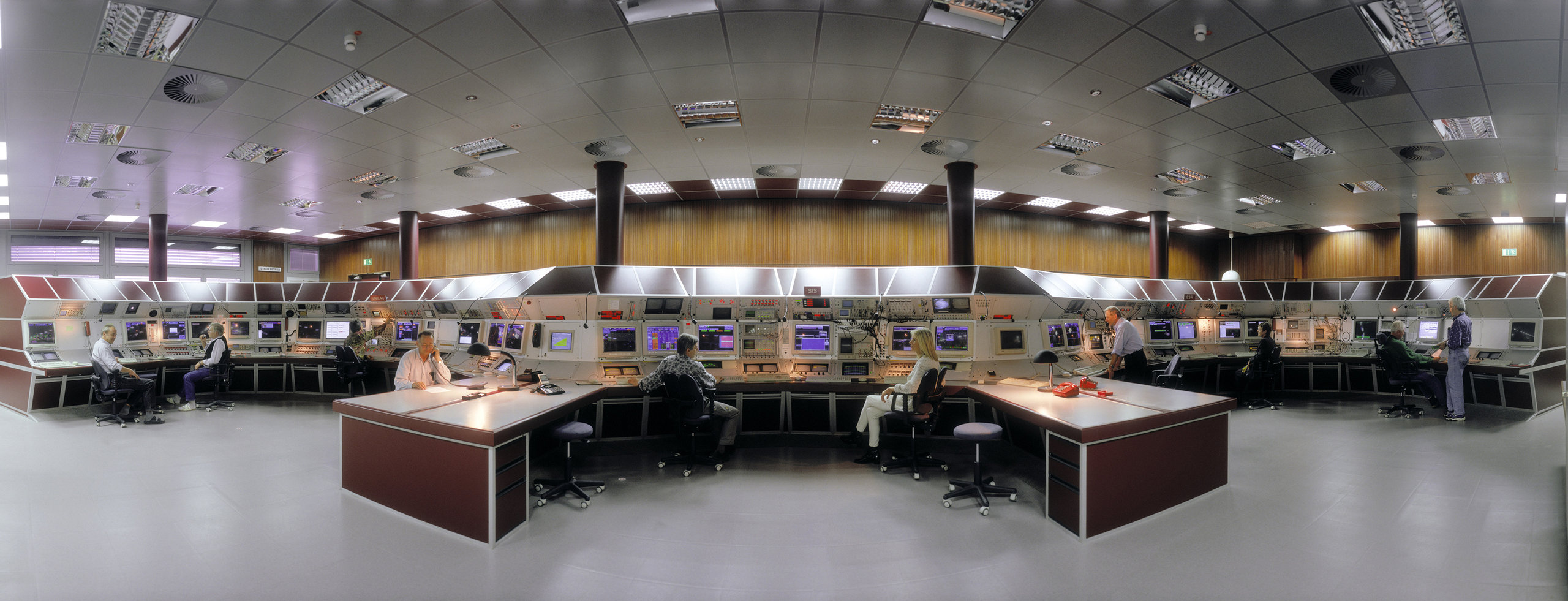Taming accelerators in the main control room
The accelerator system at GSI consists of 2,500 individual electrically controllable components such as magnets, vacuum pumps and measuring instruments. It would simply not be possible for the engineers at the facility to individually adjust all of these components by hand. That’s why the signals from all of the instruments are brought together in the main control room. All of the systems are controlled from here — in other words, everything from the ion sources, the linear accelerator UNILAC and the ring accelerator SIS to the experimental storage ring (ESR) and the magnets, strippers and electrodes that guide the ion beam to the correct experiment.
To prevent the operators from loosing their overview, the main control room is divided into three separate areas for UNILAC, SIS and ESR. Each area has its own operator. Every workplace consists of multiple monitors, control elements and oscilloscopes. Uwe Scheeler heads the operating group at GSI: “Because of the accelerator’s complex mode of operation, it is important that data related to the state of the machine is presented in a structured manner. It’s vital that you know exactly what’s going on,” he explains. Ensuring that a machine with so many individual parts is usable represents a huge challenge for the programmers. The requisite software, which is developed in the IT department at GSI, must be constantly adapted.
Ion beams to order
The task of the operators in the main control room is to generate exactly the sort of ion beam needed by the researchers in the experimental hall. There are an infinite variety of ways to accomplish this. The ion sources at GSI can produce ions of every element that occurs naturally on earth. And they can produce beams with the thickness of a pencil or a branch that have different charge states, varying intensities, and different currents. The researchers who make use of the ion beam for their research rarely come into contact with the accelerator facility. They know what kind of beam they need for their experiment, and they pass this wish on to the operators in the main control room. It’s the operators’ job to deliver an ion beam of exactly this type. The accelerator has to be set up differently for every different type of beam. To ensure the maximum possible amount of research work, fast ions are supplied to more than one experiment. After a shot of carbon ions for the biophysicists, a bunch of gold ions could be accelerated for the nuclear physicists, and finally some tin in an attempt to discover new elements. In this way, up to six experiments can be supplied with ion beams simultaneously. After all, adjusting the magnets in the linear accelerator for the various beam types requires only around 15 milliseconds—adjusting the magnets in the SIS takes less than two seconds. Once the beam is optimally adjusted, the operators monitor its exact properties and adjust them as required.
Finding the cause of faults requires experience
Should something go wrong at the accelerator, the first challenge is to find the cause of the fault. “The operators rely on their experience,” says Uwe Scheeler. “In order to be able to solve a problem, I have to know how I can collate information about the fault.” The software usually helps to locate and eliminate the cause of the fault. The top priority is to keep the experiments running as smoothly as possible. Switching off the accelerator facility and running it up again is very time-consuming. After starting up the facility, it can take the operators up to four hours of adjustment on the SIS, and up to eight hours on the UNILAC before the beam parameters are once again in order.
Working in three-shift operation
“In total, we achieve 6,400 hours of beam time in a year, that works out at around eight to nine months,” reports Uwe Scheeler. During beam time, the accelerator operates 24 hours a day, seven days a week. The operators work in three shifts. Physicists and technicians are also on call at all times, in case a problem cannot be solved immediately. “On the one hand, the work here demands a high degree of concentration; on the other hand, it also requires communication and teamwork,” says Scheeler. Some problems just can’t be foreseen. But that, says Scheeler, makes the work extremely varied. Often we start out by trying to find out how the ion beam can be made to operate optimally.
New challenges with FAIR
Once FAIR—the new “Facility for Antiproton and Ion Research”—is up and running, it will be necessary to operate even more accelerators from the main control room. The latter’s area will increase by 50 per cent to cope with the new challenge. In order to manage the huge amount of data more effectively, software engineers at GSI are already working on new programs. Many control panels are to be made more compact and will be more clearly laid out. “We’ve got some way to go before we will be able to carry out experiments using the new accelerator,” says Uwe Scheeler. "However, we will proceed step by step. And that means detailed planning."













